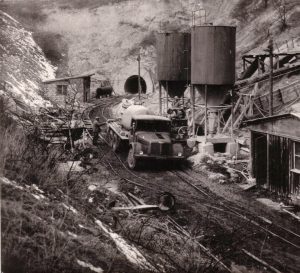© 2025 SÚRAO
Located near Litoměřice in a section of the underground complex
of the former Richard II limestone mine
The repository is located near Litoměřice in one section of the underground complex of the former Richard II limestone mine. So-called institutional waste, which is produced in the healthcare, industry, agriculture and research sectors, has been disposed of here since 1964.
Such waste consists of discarded radioactive emitters such as fire detectors, level meters, contaminated rubble, plastic and paper materials. The Richard repository also includes a certified test facility for the testing of waste containers and so-called radioactive materials of special form. This is the only such test facility in the Czech Republic.
How is such testing conducted? Waste containers are required to pass a number of demanding test procedures such as the free-fall test which involves the dropping of the container onto a steel plate from as high as 9 metres, being loaded with 5 times its weight for 24 hours, dropping onto a steel spike or being weighted by a 500 kg steel plate. Following the various mechanical tests, containers are subjected to thermal testing for 30 minutes and the so-called flame test at temperatures of up to 800°C.


In 1945 the Čížkovice cement and limestone company re-instated full-scale limestone mining at the site. Over the next 15 years, an extensive complex of corridors was constructed in the Richard I section. However, due to the high costs of the mining method employed compared to open mining, production was terminated. The alternative use of all three mines was considered in the 1950s; however, it was not until 1959 that the first official proposals were submitted to use the Richard II mine complex for the disposal of radioactive waste. The plans became reality just five years later, in 1964. An important milestone in the history of the Richard repository occurred in 1976 with the establishment of the České středohoří protected landscape area (PLA) which included the Richard II radioactive waste repository and the other two Richard mines. The inclusion of the area of the repository in the PLA proves that the repository exerts no negative effect on humans or the environment.
In 2005-2007, an international EC Phare project was conducted concerning the Richard repository. Several disposal chamber containing waste that was disposed of in the first decades of the operation of the repository were completely refurbished. Following the detailed inspection of the containers and the re-packaging of some of them, the individual disposal chambers were backfilled with concrete. Moreover, in order to allow for the monitoring of the potential leakage of water into the repository, a drainage system was built around the sealed chambers. No water has been detected in the control well since this time.
The total volume of the Richard II mine is over 19,000 m3. The capacity of the disposal chambers is 10,250 m3, of which 70% has been filled to date. The graph illustrates the amounts of waste disposed of in individual years since the repository was transferred to SÚRAO management.

